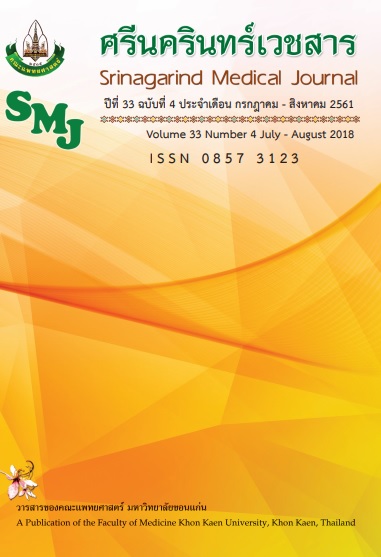การพัฒนาแนวปฏิบัติในการให้ออกซิเจนก่อนนำสลบ โรงพยาบาลขอนแก่น
คำสำคัญ:
แนวปฏิบัติ; การให้ออกซิเจนก่อนนำสลบบทคัดย่อ
ป้องกันภาวะพร่องออกซิเจนระหว่างการนำสลบในการดมยาสลบแบบทั่วตัว โรงพยาบาลขอนแก่นมีอุบัติการณ์พร่องออกซิเจน 1-2 ราย/เดือนและร้อยละ 30 เกิดในช่วงนำสลบ บุคลากรวิสัญญีมีวิธีการให้ออกซิเจนก่อนนำสลบแตกต่างกัน การศึกษานี้มีวัตถุประสงค์เพื่อพัฒนาแนวปฏิบัติในการให้ออกซิเจนก่อนนำสลบ และวัดผลลัพธ์การใช้แนวปฏิบัติและประเมินความพึงพอใจของผู้ใช้แนวปฏิบัติ
วิธีการศึกษา: เป็นการศึกษาเชิงปฏิบัติการ (action research) ใช้ขั้นตอนพัฒนาแนวปฏิบัติของศูนย์ปฏิบัติการพยาบาลขั้นสูงมี4 ขั้นตอน ได้แก่ การวิเคราะห์ปัญหา สืบค้นหลักฐานเชิงประจักษ์เพื่อพัฒนาแนวปฏิบัติ ตรวจสอบโดยผู้เชี่ยวชาญ นำแนวปฏิบัติไปทดลองใช้กับผู้ป่วย และปรับปรุงให้เหมาะสม นำไปใช้กับผู้ป่วยอีกครั้ง ประเมินผลลัพธ์และความพึงพอใจ
ผลการศึกษา: มีผู้ปฏิบัติ 40 ราย แนวปฏิบัติมี 7 ขั้นตอน นำมาใช้กับผู้ป่วย103ราย ร้อยละ 69.9 เป็นเพศหญิง และร้อยละ 49.5 เป็นผู้ป่วยASA physical status 1 ผลการใช้พบว่า เวลาเฉลี่ยที่ทำให้ETO2เป็นร้อยละ80 คือ 61.36 วินาที สามารถหยุดหายใจนานมากกว่า 4.8 นาทีโดยไม่เกิดภาวะพร่องออกซิเจน ผู้ปฏิบัติร้อยละ82.5 มีความพึงพอใจมากที่สุด และร้อยละ 17.5 พึงพอใจมาก
สรุป: แนวปฏิบัติในการให้ออกซิเจนก่อนนำสลบ โรงพยาบาลขอนแก่น สามารถใช้ได้อย่างมีประสิทธิภาพ และปลอดภัย
เอกสารอ้างอิง
2. Tanoubi IS. Oxygenation before anesthesia (preoxygenation) in adults. Anesthesiol Rounds 2006;5(3)(Cite by 7).
3. American Society of Anesthesiologists Task Force on Management of the Difficult Airway. Practice guidelines for management of the difficult airway. An updated report. Anesthesiology 2003; 98: 1269-77.
4. Punjasawadwong Y, Chinachoti T, Charuluxananan S, Pulnitiporn A, Klanarong S, Chau-in W, Rodanant O. The Thai Anesthesia Incidents Study (THAI Study) of oxygen desaturation. J Med Assoc Thai 2005; 88(Suppl 7): S41-53.
5. Suksompong S, Chatmongkolchat S, Hintong T, Klanarong S, Cha-in W, Virankabutra T. The Thai Anesthesia Incident Monitoring Study (Thai AIMS) of desaturation: an analysis of 1,996 incident reports. J Med Assoc Thai 2008; 91: 1389-96.
6. Gambee AM, Hertzka RE, Fisher DM. Preoxygenation techniques: comparison of three minutes and four breaths. Anesth Analg 1987; 66: 468-70.
7. Baraka AS, Taha SK, Aouad MT, El-Khatib MF, Kawkabani NI. Preoxygenation comparison of maximal breathing and tidal volume breathing techniques. Anesthesiology: Anesthesiology1999; 91: 612-6.
8. Nimmagadda U, Salem MR, Joseph NJ, Lopez G, Megally M, Lang DJ, Wafai Y. Efficacy of Preoxygenation with Tidal Volume Breathing Comparison of Breathing Systems. Anesthesiology 2000; 93: 693-8.
9. Baraka AS, Salem MR. Preoxygenation. In: Hagberg CA, Gabel JC, editors. Benumof and Hagbers’s airway management. 3th Ed. Philadelphia: Elsevier saunders; 2013: 280-97.
10. Nimmagadda U, Chiravuri SD, Salem MR, Joseph NJ, Wafai Y, Crystal GJ, El-Orbany MI. Preoxygenation with tidal volume and deep breathing techniques: the impact of duration of breathing and fresh gas flow. AnesthAnalg 2001; 92: 1337-41.
11. เข็มเพชร เศรษฐ์สัมพันธ์ , เวณิกา แพงวงษ์, อักษร พูลนิติพร. Preoxygenation with Oxygen-prefilled Anesthesia Breathing System Increased End Tidal Oxygen within Two minute :A Randomized Controlled Trial. Thai J Anesthesiology 2018; 44: 51-7.
12. Baraka A. " Routine" preoxygenation before induction of and recovery from anesthesia (a safety precaution)(Editorial). Middle East J Anesthesiol 2010; 20: 769-71.
13. Nimmagadda U, Salem MR, Crystal GJ. Preoxygenation: physiologic basis, benefits, and potential risks. Anesth Analg 2017; 124: 507-17.
14. Soukup SM. The Center for Advanced Nursing Practice evidence-based practice model: promoting the scholarship of practice. Nurs Clin North Am 2000; 35: 301-9.
15. Tanoubi I, Drolet P, Donati F. Optimizing preoxygenation in adults. Can J Anesth 2009 ;56:449-66.
16. Nimmagadda U, Salem MR, Joseph NJ, Miko I. Efficacy of preoxygenation using tidal volume and deep breathing techniques with and without prior maximal exhalation. Can J Anesth 2007; 54: 448-52.
17. Pandit JJ, Duncan T, Robbins PA. Total Oxygen Uptake with Two Maximal Breathing Techniques and the Tidal Volume Breathing Technique A Physiologic Study of Preoxygenation. Anesthesiology 2003; 99: 841-6.
18. Lane S, Saunders D, Schofield A, Padmanabhan R, Hildreth A, Laws D. A prospective, randomised controlled trial comparing the efficacy of preoxygenation in the 20° head up vs supine position. Anaesthesia 2005; 60: 1064-7.
19. Melnyk BM, Fineout-Overholt E, editors. Evidence-based practice in nursing & healthcare: A guide to best practice. Lippincott Williams & Wilkins; 2011.
20. อรุณ จิรวัฒน์กุล. ชีวสถิติสำหรับงานวิจัยทางวิทยาศาสตร์สุขภาพ.ขอนแก่น : โรงพิมพ์คลังนานาวิทยา; 2551.
21. BARAsH PA, Cullen BF, Stoelting RK, Cahalan M, Stock MC, Ortega R. Handbook of clinical anesthesia,7thEd. Lippincott Williams & Wilkins; 2013:774.




